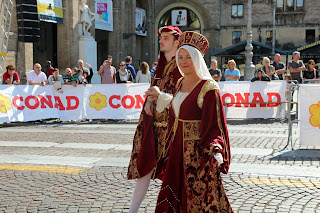I stopped
wearing a watch in 2010. I reasoned I didn't need one. If I was driving, my
car dashboard had the time. The television cable box told the time. If I was at my
computer, a glance at the bottom corner gave me the time. If I was away from
the desk, car or home, my cell told the time in several different ways,
from a read out on the top of the screen to an app that gave me the time in multiple time cities and time zones.
It was the same for my iPad. And with most being tied to the atomic clock, they
were always accurate than my Timex which needed the occasional adjustment. Hence I reasoned, why wear a time telling instrument when
clocks in various forms were all around me.
I started to change my mind
this past spring. By May I decided to look for new watch, one that would be far more fashionable than the old Timex. Yet the price had to be right for my budget.
By early summer I concluded that when I’m away from my car, desk and not
using the iPad that there are times when having a watch is wise. While my cell phone was normally
with me, there are times when using a cell phone to check the time is problematic
because each us being prone to make snap judgments upon what we perceive others doing.
For example,
if you are in a conversation with an acquaintance, and that person asks you to meet
them in 15 minutes to help them set something up, and you’re not wearing a
watch, what do you do? You would may well look at your phone to note the current time so
as to meet the person at the appointed time. While the person with whom you are
speaking may notice you checking the time, an onlooker over 40 years of age will
likely judge the action differently.
Their perception is their reality, and
without a fuller understanding create a conclusion in their mind that doesn't match with how the two participants are viewing matters. Being of the older generation where watch wearing was almost universal in my younger years, I’ve fallen into the trap of misjudging someone in this way once until
I realized that the young lady in question rarely wore a watch and wasn't doing so at that moment. She was not being rude to
the person at all. In fact it was the
opposite. By ensuring she would be at the appointed time as requested she was being respectful and responsible. Have I been judged the same? I'm certain that
I've been judged by others in the similar manner for whenever the question of time comes in a conversation would at my time piece, the phone. Yet to an observing person, they likely would not interpret a look at the phone in the same way as they would for a person checking of a watch.
Last spring
while attending a business meeting in Fairfax. The members were seated in a square
discussing the association’s budget. The only clock in the room
was on the wall opposite me. During the discussion I noticed a member
directly across from me looking at his cell several times. At first my impression was that he was checking
his email and that there was a lack of interest and focus upon the
business at hand. Minutes later a subsequent statement to the issue at hand
indicated he had been following the discussion. Shortly after making his comment, he again
checked his phone and left the meeting while apologizing for having to leave early. It was then that I noticed that like me he was
not wearing a watch. My earlier interpretation was not only erroneous and did a
disservice to him for he was not checking
his email or disengaged from the business at hand, he was checking his watch to ensure that he left on time.
In the
subsequent weeks I decided to look for a new watch. While I thought of buying one of
the fancy electronic watches from which one can surf the net, I decided not to go in that direction. They are bulky, not overly stylish and their technology would soon be dated. So I focused upon an old
fashion style watch that would be stylish and easily last 25+ years. It also
had to fit the budget…a $300 to $800 watch was well out of my price range, and
not justifiable. Nor was a $25 Timex the watch for me. I've finally found a lovely and stylish
watch that was being sold a fantastic price point.
So that is
why I’ve returned to wearing a watch a few weeks ago.



























































